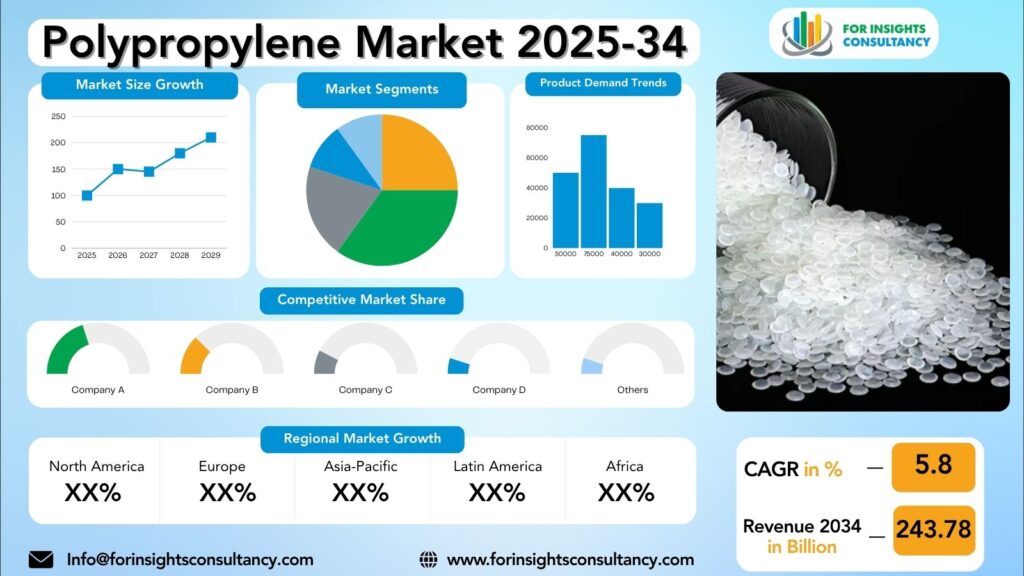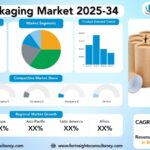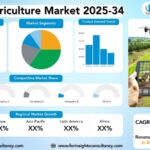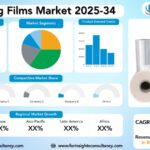
Polypropylene Market Size, Trends Analysis Research Report By Type (Homopolymer, Copolymer), by Processing Technology (Injection Molding, Extrusion Molding, Blow Molding, Fiber & Raffia, Film & Sheet, Others), by End-User Industry, and By Region Global Market Analysis And Forecast, 2025-2034
Oct-2025 Formats | PDF | Category: Chemical | Delivery: 24 to 72 Hours
The report highlights that the market outlook is significantly influenced by swift shifts in global trade relations and tariffs. It emphasizes the necessity of updating the report before delivery to incorporate the most current status, which includes revised market forecasts and a comprehensive analysis of the quantified impacts of these changes.
Polypropylene Market Is Forecast to Increase from USD 146.69 Billion In 2025 To USD 243.78 Billion By 2034, At A CAGR Of 5.8%.
Polypropylene Market: A Comprehensive Overview and Future Developments
The polypropylene market is currently experiencing significant growth, primarily due to its extensive application across multiple sectors, including packaging, automotive, construction, and textiles. Known for its lightweight and durable characteristics, polypropylene is a thermoplastic polymer that also offers heat resistance, cost-effectiveness, and recyclability, making it a preferred material in these industries.
Looking ahead, the market is anticipated to evolve with advancements in manufacturing processes aimed at improving product quality and sustainability. Innovations in the production of bio-based polypropylene and developments in recycling technologies are expected to become more prominent in response to environmental concerns and increasingly stringent regulations. Moreover, the rising demand for polypropylene in emerging economies, as well as its adoption in new applications such as 3D printing and medical devices, is likely to further accelerate market growth and transform the overall industry landscape.
Market Insights
- Asia Pacific region consistently holds the largest share of the global polypropylene market revenue in 2024, with reported shares 59.27% in the total market
- The percentage of the U.S. population living in urban areas in 2024 is estimated to be approximately 82.8 %.
- Largest Revenue Share Segment in 2024-Packaging or Automotive-The Packaging industry is frequently cited as the leading segment, holding around 51.83% of the revenue share in 2024 in some reports.
- The Automotive segment is also a major revenue holder, sometimes cited as the biggest, or the fastest growing due to lightweighting trends.
AI Impact
Polypropylene Market is being profoundly influenced by the implementation of AI technology, which is transforming various aspects of the industry. AI is playing a critical role in optimizing production processes, leading to enhanced product quality and more efficient supply chain management. The adoption of AI-powered predictive analytics allows companies within the polypropylene sector to forecast demand with greater precision, thereby reducing waste and streamlining operations to achieve cost efficiency. Additionally, AI is utilized for quality control inspections, enabling firms to detect defects and maintain high product standards. As a result, AI is fostering innovation and improving competitiveness in the polypropylene market, facilitating smarter decision-making, lowering operational costs, and boosting overall productivity.
Market Dynamics
Trends
The polypropylene market is currently influenced by several significant trends that are reshaping the industry dynamics. A key trend is the increasing demand for sustainable and eco-friendly polypropylene materials, which is largely attributed to heightened environmental awareness among consumers and regulatory pressures aimed at reducing plastic waste. In addition to this, there is a notable rise in the adoption of recycled polypropylene products as manufacturers strive to mitigate their carbon footprints and decrease production costs. Furthermore, advancements in technology related to polypropylene production processes are emerging, specifically the innovation of energy-efficient and cost-effective manufacturing techniques. Collectively, these trends signal a substantial shift within the industry towards more sustainable practices and the development of innovative solutions to satisfy the growing appetite for polypropylene materials.
Growth Drivers
The global polypropylene market is witnessing substantial expansion, primarily influenced by several critical factors. One of the foremost drivers of this growth is the rising demand for sustainable and eco-friendly packaging solutions across multiple industries. Polypropylene, recognized for its versatility and recyclability, is increasingly utilized in the packaging sector, thereby propelling market advancement.
In addition, the automotive and construction industries are contributing to this growth through their demand for lightweight yet durable materials. Polypropylene stands out in these sectors due to its excellent strength-to-weight ratio and impressive resistance to various chemical and environmental factors, which makes it a favored material choice.
The healthcare sector is also capitalizing on the advantages of polypropylene, utilizing it in the production of medical devices, laboratory equipment, and disposable packaging. This trend is further enhancing market growth prospects. Overall, the escalating adoption of polypropylene in a multitude of end-use industries is poised to significantly drive the market forward in the upcoming years.
Restraints
Restraints in the polypropylene market are influenced by several key factors that present challenges to its growth and sustainability. Firstly, fluctuating raw material prices create uncertainty and complications in budgeting for manufacturers, as the costs associated with production can vary significantly over time. Furthermore, stringent environmental regulations are becoming increasingly prevalent, reflecting a global shift towards sustainability and the reduction of plastic waste. This regulatory environment is exacerbated by mounting concerns regarding the environmental impact of plastic products, driving a rising demand for sustainable alternatives to polypropylene.
Additionally, the polypropylene market faces stiff competition from alternative materials, such as polyethylene and polyvinyl chloride, which may offer more environmentally friendly options. Another critical factor is the volatility in oil prices, which directly affects the cost of producing polypropylene, thereby complicating manufacturers’ ability to implement stable pricing strategies. To navigate these challenges effectively and promote long-term growth within the market, there is a pressing need for innovation, particularly in the areas of recycling and the reuse of polypropylene materials. Advances in these fields could not only mitigate the restraints posed by environmental concerns but also bolster the market’s resilience against raw material fluctuations and heightened competition.
Opportunities
The polypropylene market is currently poised for considerable growth and expansion, primarily driven by several key factors. The increasing demand for lightweight and durable materials across various sectors, including automotive, packaging, and construction, offers substantial opportunities for polypropylene manufacturers to meet emerging needs. Furthermore, the growing focus on sustainability and recyclability is significantly elevating the interest in eco-friendly polypropylene products.
Innovative advancements in production processes, along with the development of high-performance grades of polypropylene, present market players with avenues to differentiate their offerings and capture a larger share of the market. As the global economy continues its recovery, the polypropylene market showcases a favorable outlook characterized by opportunities for investment, partnerships, and technological advancements that promise to propel further growth. Overall, the intersection of demand for sustainable materials and technological innovation will likely shape the future of the polypropylene industry.
Challenges
The polypropylene market is currently confronted with several significant challenges that could impede its growth and long-term sustainability. A primary issue is the volatility in raw material prices, particularly the price of propylene, which is essential for polypropylene production. This price variability is influenced by numerous factors, including changing supply-demand dynamics and geopolitical events that can disrupt market stability. Additionally, environmental concerns regarding the use of plastics, especially polypropylene, are prompting a shift towards more sustainable and eco-friendly alternatives. As a result, there is increased pressure from both consumers and regulatory bodies for companies to develop and adopt more environmentally responsible practices. Moreover, existing regulations and policies aimed at minimizing plastic waste and encouraging recycling add another layer of complexity for the polypropylene market. Companies must adapt to meet these evolving standards, which requires innovation and investment in new technologies. Thus, effectively navigating these multifaceted challenges is essential for the polypropylene industry to maintain its competitiveness and ensure its future viability in the market.
Polypropylene Market Top Companies Covered In This Report:
Evaluate The Strategic Positioning And Innovation Pipelines Of Leading Market Companies-From Multinational Enterprises To Disruptive Regional Firms. Understand How Key Players Are Innovating, Expanding, And Capturing Value, And Use Competitive Benchmarks To Plan Your Next Move.
- Exxon Mobil Corporation
- LyondellBasell Industries Holdings B.V.
- SABIC
- Braskem
- INEOS
- Reliance Industries Limited (RIL)
- China Petrochemical Corporation
- Sinopec Corporation
Polypropylene Market Company News 2024 and 2025
LyondellBasell
June 2024 Announced the start-up of an additional production line at its Dalian, China, Advanced Polymer Solutions (APS) site, doubling the site’s current capacity for high-performance polypropylene compounds.
Braskem
September 2024 Launched a new Bio-Circular Polypropylene (PP) product line.
ExxonMobil and SABIC
2024 Mentioned in market reports to be undergoing strategic reviews or capacity rationalization, particularly in the challenging European market, similar to LyondellBasell’s actions.
Dangote Group
May 2025 Announced a collaboration with Premier Product Marketing LLC (a Vinmar company) to market its Dangote Polypropylene outside of Nigeria and Africa to global markets.
Segmented View of The Industry:
The Polypropylene Market Is Mapped Through A Multidimensional Lens-Tracking Shifts Across Product Type, Applications, And Geographic Regions. This Segmented Approach Enables Businesses to Localize Their Growth Plans And Align Offerings With The Most Profitable Demand Centres.
Segmentation By Type
- Homopolymer
- Copolymer
Segmentation ByProcessing Technology
- Injection Molding
- Extrusion Molding
- Blow Molding
- Fiber & Raffia
- Film & Sheet
- Others
Segmentation ByEnd-User Industry
- Packaging
- Automotive
- Consumer Goods/Lifestyle
- Electrical & Electronics
- Building & Construction/Infrastructure
- Healthcare & Pharmaceuticals
- Agriculture
- Others
Global Geographic Coverage:
The Report Provides In-Depth Qualitative And Quantitative Data On The Polypropylene Market For All Of The Regions And Countries Listed Below:
North America
The polypropylene market in North America is anticipated to expand, with the region experiencing a projected GDP growth of 3.5% and an inflation rate of 2.1%. In the United States, government subsidies aimed at fostering sustainable packaging solutions have positively influenced market dynamics. The primary distribution method for polypropylene products remains through industrial suppliers; however, e-commerce is gaining traction as the fastest-growing channel, largely due to its convenience and competitive pricing options. A notable trend among consumers in North America is the increasing emphasis on sustainability, ethical sourcing, and local production when selecting polypropylene products. This eco-conscious consumption pattern is particularly notable in emerging markets, where consumers are in pursuit of affordable and environmentally friendly products. Additionally, the localism movement is significant, with consumers demonstrating a strong preference for products that are locally sourced and manufactured.
Europe
In the European polypropylene market, a moderate GDP growth of 2.5% is projected, accompanied by an inflation rate of 1.8%. A notable government subsidy in Germany aimed at promoting green initiatives is significantly influencing the demand for sustainable polypropylene products, positioning Germany as a crucial player in the regional market. The primary distribution channel in this market is industrial suppliers, although e-commerce is rapidly emerging as the fastest-growing channel, propelled by the trend of increasing digitalization. Consumers show a pronounced preference for sustainability and ethical sourcing, emphasizing a demand for products that exhibit minimal environmental impact. In contrast, in emerging markets such as Poland and Romania, consumers are more focused on price and status, seeking affordable polypropylene options without sacrificing quality.
Asia Pacific
The Polypropylene market in the Asia Pacific region is on track for significant growth, driven by a projected GDP growth of X% and an inflation rate of Y%. A notable development in [Specific Country] is a government subsidy designed to support local manufacturers, which has substantially increased polypropylene production and given these local players a competitive edge in distribution. Despite this, online platforms have emerged as the fastest-growing channel for polypropylene due to their convenience and easy access for consumers.
A shift in consumer behavior is evident, with increased prioritization of sustainability and ethical sourcing leading to heightened demand for eco-friendly polypropylene products. Additionally, localism plays a critical role in purchasing decisions, with consumers showing a marked preference for goods produced domestically. In several emerging markets across the Asia Pacific, factors such as price and product status significantly influence buying behaviors, underscoring the importance of implementing competitive pricing strategies alongside premium branding initiatives to attract diverse consumer segments.
Middle East and Africa
The polypropylene market in the Middle East and Africa is expected to experience steady growth driven by factors such as GDP growth and stable inflation rates. In the Middle East, a government subsidy supporting the manufacturing sector significantly enhances the demand for polypropylene. Conversely, in Africa, the rise of media campaigns promoting eco-friendly products is shaping consumer preferences. The most prevalent distribution method for polypropylene in the region remains established industrial suppliers; however, e-commerce platforms are emerging as the fastest-growing channel, providing consumers with a diverse selection of plastic products. There is a marked increase in consumer demand for sustainable and ethically sourced products, which requires companies to integrate these considerations into their business models. Nonetheless, in many emerging markets, purchasing decisions are still heavily influenced by price and product status, highlighting the importance for businesses to adopt competitive pricing strategies while integrating sustainability into their operations.
Reasons To Buy:
- The Research Would Help Top Administration/Policymakers/Professionals/Product Advancements/Sales Managers And Stakeholders In This Market In The Following Ways.
- The Report Provides Polypropylene Market Revenues At The Worldwide, Regional, And Country Levels With A Complete Analysis To 2034 Permitting Companies To Analyze Their Market Share And Analyze Projections, And Find New Markets To Aim For.
- To Understand The Most Affecting Driving And Restraining Forces In The Market And Their Impact On The Global Market.
- Major Changes And Assessment In Market Dynamics And Developments.
- The Objective Of The Polypropylene Market Report Is To Identify New Business Opportunities Using Quantitative Market Forecasts.
- Formulate Sales And Marketing Strategies By Gaining An Understanding Of Competitors, Their Positioning, And Strengths & Weaknesses.
Faq – What Global Leaders Are Asking
What Is The Growth Prospect For The Polypropylene Market By 2034?
Polypropylene Market Is Expected To Achieve A Stable Growth Rate With A Compound Annual Growth Rate (CAGR) Of About 5.8% From 2025 Through 2034.
What Is Driving The Growth Of The Polypropylene Market?
The growth of the Polypropylene (PP) market is primarily driven by the increasing demand for lightweight, durable materials in the packaging and automotive (especially EV) industries, coupled with a rising global focus on sustainable and circular solutions.
Who Are The Key Players In The Polypropylene Market, And What Are Their Market Shares?
The Polypropylene Market Includes Major Companies Exxon Mobil Corporation, LyondellBasell Industries Holdings B.V., SABIC, Braskem, INEOS, Reliance Industries Limited (RIL), China Petrochemical Corporation, Sinopec Corporation, Others.
Specific Market Share Data Is Not Publicly Available And Is Typically Provided In Detailed, Proprietary Market Research Reports.
Which Regions Are Leading The Polypropylene Market Growth?
Asia-Pacific is the largest and fastest-growing region, primarily driven by industrialization and high demand from the packaging and automotive sectors in countries like China and India.
Customized Report as per your Business Needs
- Our analysts will work directly with you and understand your needs
- Get data on specified regions or segments, competitor and Vendors
- Data will be formatted and presented as per your requirements
Any Requirement Contact Us: Https://Www.Forinsightsconsultancy.Com/Contact-Us/
Table of Contents
For TOC Contact us: https://forinsightsconsultancy.com/contact-us/







